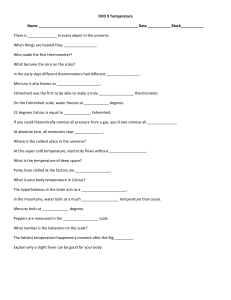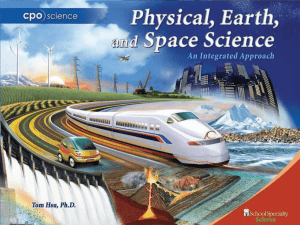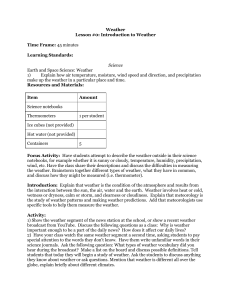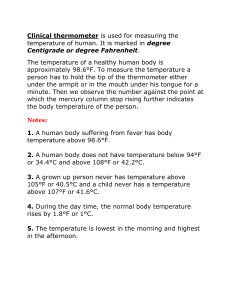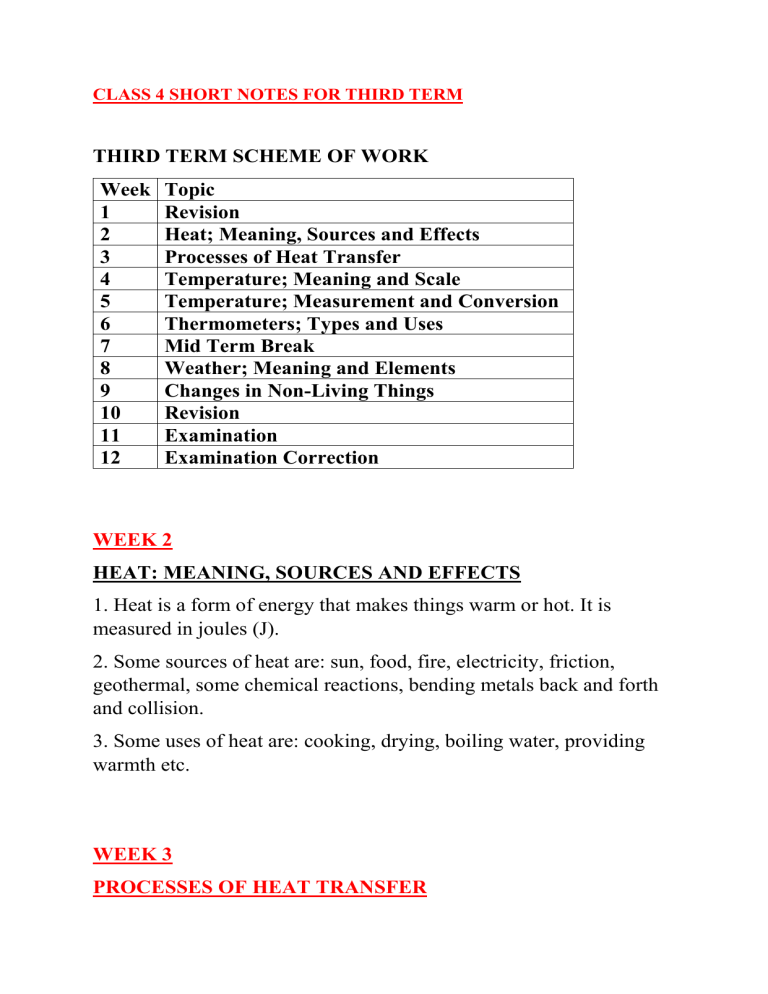
CLASS 4 SHORT NOTES FOR THIRD TERM THIRD TERM SCHEME OF WORK Week 1 2 3 4 5 6 7 8 9 10 11 12 Topic Revision Heat; Meaning, Sources and Effects Processes of Heat Transfer Temperature; Meaning and Scale Temperature; Measurement and Conversion Thermometers; Types and Uses Mid Term Break Weather; Meaning and Elements Changes in Non-Living Things Revision Examination Examination Correction WEEK 2 HEAT: MEANING, SOURCES AND EFFECTS 1. Heat is a form of energy that makes things warm or hot. It is measured in joules (J). 2. Some sources of heat are: sun, food, fire, electricity, friction, geothermal, some chemical reactions, bending metals back and forth and collision. 3. Some uses of heat are: cooking, drying, boiling water, providing warmth etc. WEEK 3 PROCESSES OF HEAT TRANSFER There are three methods of heat transfer. 1. Conduction This is the process of heat transfer between objects in contact. It occurs in solids and liquids. Examples: A metal spoon in hot chocolate and a rod put into fire. 2. Convection This is the process by which heat is transmitted in liquids and gases by the actual movement of the heated particles. Example a. Boiling water in a container. b. Feeling cool breeze from an air conditioner or a fan. 3. Radiation This is the process of heat transfer in space or vacuum. Example: a. Heat from the sun. b. Feeling heat from a toaster or oven. WEEK 4 TEMPERATURE: MEANING AND SCALE 1. Temperature is how hot or cold an object, body or place is. 2. The temperature of an object is measured in degrees. 3. The degrees can be in different temperature scales namely: a. Degrees Celsius or Degrees Centigrade (˚C) b. Degrees Fahrenheit (˚F). c. Kelvin (K). WEEK 5 TEMPERATURE: MEASUREMENT AND CONVERSION 1. The instrument for measuring temperature is called a thermometer. 2. To convert from Celsius to Fahrenheit, multiply the temperature in Celsius by 9, divide your answer by 5, then add 32. 3. To convert from Fahrenheit to Celsius, subtract 32, multiply the result by 5, then divide by 9. 4. To convert from 0C to Kelvin, add 273. 5. To convert from Kelvin to 0C, subtract 273. WEEK 6 THERMOMETERS: TYPES AND USES 1. There are analog and digital thermometers. An analog thermometer shows the temperature on a scale or dial; a digital thermometer shows the temperature as a number. 2. Some types of thermometers are: a. Clinical Thermometers b. Room thermometers c. Industrial thermometers d. Wet and Dry bulb thermometers e. Infra-red thermometers WEEK 7 MID TERM BREAK WEEK 8 WEATHER: MEANING AND ELEMENTS 1. Weather is the condition of the atmosphere of a place at a particular time. 2. Climate is the average weather condition of a place over a long period, usually 30 years. Some elements of weather and the instruments used in measuring them: 1 2 Weather Elements Wind direction Wind speed Measuring Instrument Wind vane Anemometer 3 4 5 6 7 8 Temperature Atmospheric Pressure Rainfall/Snow Humidity Sunshine Clouds Thermometer Barometer Rain gauge/Snow gauge Hygrometer Sunshine recorder Ceilometer WEEK 9 CHANGES IN NON-LIVING THINGS Change means when something becomes different. Types of Changes 1. Temporary, Reversible or Physical Change. In this type of change, no new substance is formed. Examples are I. II. III. IV. V. Boiling of water Evaporation Freezing Melting Change in size and shape such as cutting paper. 2. Permanent, Irreversible or Chemical change. In this type of change, a new substance is formed. Examples are: I. II. III. IV. V. Rusting Cooking Baking Action of vinegar on bicarbonate of soda Adding water to Plaster of Paris CLASS FOUR EXTENDED NOTES FOR THIRD TERM WEEK 1- REVISION WEEK 2 HEAT: MEANING, SOURCES AND EFFECTS What is Heat? 1. Heat is a form of energy that makes things warm or hot. 2. Heat is measured in joules (J). 3. Heat can change the state of matter, increase temperature and size of things. 4. We feel hot when the Sun shines. This shows that the Sun is a source of heat energy and gives out heat. Most of the heat on the Earth comes from the Sun. Other Sources of Heat • Apart from the Sun, there are many other sources of heat. Heat can be produced in many ways. • Here are some activities to show possible heat sources. Heat Sources Friction-: Rubbing two objects against each other can produce heat. Activities Rub your hands together for some time and then hold them to your cheeks. Your cheeks will feel warm, showing that heat can be produced by friction. Burning-: When an object burns, it produces a flame (fire) that gives out heat. Burn a candle or a piece of paper and put your hands above it. Your hands will feel hot, showing that burning substances can produce heat. Electricity: When electric current flows through a wire, heat is produced. Switch on the electric bulb for some time and place your hands near the bulb. Your hands can feel the heat coming out from the bulb. You can also try it out with a flash light. Bending Metal Bending a coat hanger or a wire back and forth several times can produce heat in the object. Chemical reaction After mixing solid sodium hydroxide with water in a test tube, the test tube will get warm. Collision When an iron nail is hit by a hammer several times, the hammer and the nail will get hot. Uses of Heat in our Daily Life Heat is a useful form of energy. We use heat to; a. b. c. d. e. f. Cook food Dry clothes Boil water Produce steam to generate electricity Dry food for reservation Provide warmth FURTHER READING First Aid in Science pages 56 to 57 WEEK 3 HEAT TRANSFER PROCESSES 1. Heat only travels from a hotter object (or place) to a cooler object (or place) 2. Heat has several interesting ways of travelling: It travels in three ways: By conduction through solids. By convection through liquids or gases. By radiation through vacuum. CONDUCTION 1. The flow of heat energy through solids such as metals is called conduction. 2. Heat energy uses molecules to help get around. 3. For example, when a pan is heated, the molecules at the bottom of the pan start to vibrate energetically. They collide with their neighbouring molecules and cause them to vibrate faster. The passing of the heat energy from one molecule to the next continues. In this way, heat energy travels through the pan and then through the food in the pan. CONVECTION 1. Heat can flow through a liquid or gas because heated parts of the liquid gas move. 2. Warm air rising above a heater is an example of the process of convection. 3. The flow of heat that occurs when a warm liquid or gas moves is known as convection. RADIATION 1. The process where heat energy travels through an empty space or a vacuum is known as radiation. 2. An example of radiation is the transfer of heat from the Sun to the Earth through mostly empty space. Such a transfer cannot occur via convection or conduction, which requires the movement of material from one place to another, or the collisions of molecules within a material. WEEK 4 TEMPERATURE: MEANING, SCALE AND MEASUREMENT 1. Temperature is the degree of how hot or cold something is. 2. A Thermometer measures the temperature of something, showing how hot or cold it is. 3. There are analog and digital thermometers. An analog thermometer shows the temperature on a scale or dial; a digital thermometer shows the temperature as a number. Temperature Scales 1. Temperature is measured in different scales, which includes Fahrenheit, Celsius (or Centigrade) and Kelvin scales. The units of the Celsius and Fahrenheit scales are called degrees. a. Fahrenheit: Fahrenheit is a measure of temperature that is abbreviated F. Water freezes at 32°F and boils at 212°F. This scale was developed by Gabriel Daniel Fahrenheit in 1714. The Fahrenheit scale is used in the USA but not in many other countries. The degrees in Fahrenheit are smaller than those in Celsius. b. Celsius or Centigrade: Celsius (also called Centigrade) is a measure of temperature that is abbreviated C. Water freezes at 0°C and boils at 100°C. This scale was developed by Anders Celsius in 1742. Celsius scale is used in most countries of the world like Nigeria, Great Britain, China etc. c. Kelvin: Kelvin is a measure of temperature that is abbreviated K. Many scientists use this scale because all the temperatures are positive, making calculations simpler. This temperature scale was designed by Lord Kelvin (William Thomson). WEEK 5 TEMPERATURE: CONVERSION WEEK 6 THERMOMETERS: TYPES AND USES 1. A Thermometer measures the temperature of something, showing how hot or cold it is. 2. We use thermometers to measure the temperature of the air, our bodies, food and many other things. 3. There are analogue and digital thermometers. a. An analogue thermometer shows the temperature on a scale or dial and requires skill to read. It can be mercury-in-glass or alcohol-in-glass. PARTS OF ANALOGUE THERMOMETERS. i. Glass tube: - The tube that holds the glass bulb and the mercury/alcohol. ii. Scale: - This tells how far the mercury/alcohol rises or goes down. iii. Mercury/Alcohol: - The liquid inside the bulb which rises when hot and goes down when it is cool. iv. Glass bulb: - The bulb which contains the mercury/alcohol b. A digital thermometer shows the temperature as a number and requires no skill to read. Some other types of thermometers are: i. Clinical Thermometers: - a small medical thermometer used for taking a person’s temperature. ii. Room Thermometer: - measures the indoor air temperature. iii. Industrial Thermometers: - are used to measure the temperature of chemicals and other substances. iv. Wet and Dry bulb Thermometer: - measures the temperature of the atmosphere. v. Wall Thermometer: - can be used both indoors and outdoors. vi. Infrared thermometers: - designed for non-contact measurement of very high and low surface temperature Clinical Wet and Dry Bulb Room Industrial Infrared Wall WEEK 7- MIDTERM BREAK WEEK 8 WEATHER: MEANING AND ELEMENTS 1. Weather is defined as the condition of the atmosphere at a given time. It is simply seen as the degree at which a place is hot or cold, wet or dry, clear or cloudy and calm or stormy. 2. Climate is defined as the average weather condition of a place over a given period, usually over 30 years. Elements of Weather Common elements of weather include precipitation, temperature, humidity, cloudiness, atmospheric pressure and wind; they are what bring about the sudden changes in weather condition. a. Precipitation- precipitation is a form of water in the atmosphere that falls to the earth. This falls after cloud has been formed in the sky, forms of precipitation include rain, snow, fog, mist, hail, sleet and drizzle. b. Temperature- temperature measures the degree of hotness or coldness of a place from day- to-day. c. Humidity- humidity is simply the amount of water vapour in the air or in the lower atmosphere. d. Cloudiness- this is simply the state of clouds in the atmosphere in a given time over an area. Different types of clouds mean different weather conditions. For instance, lighter cloud indicates little or no precipitation, while dark heavy cloud indicates that there will be heavy rain or thunderstorms. e. Atmospheric Pressure- Atmospheric pressure is the "weight" of the air in the atmosphere. Changes in atmospheric pressure are mostly caused by the rise of warm air and the descent of cold air. f. Wind- wind is the air in motion that moves from areas of high air pressure to those of low air pressure, wind occurs due to rising hot air or sinking cold air. Weather Instruments and their Uses These are the common weather elements and instruments used in measuring them: 1. Precipitation- precipitation is measured with a rain gauge. A rain gauge measures the amounts of water that falls at a particular time. Picture of rain gauge 2. Temperature- a thermometer is used to measure temperature of the day (max/min temperatures). Picture of thermometer 3. Atmospheric pressure- this is measured with use of a Barometer. Picture of a Barometer 4. Humidity- humidity is measured with the use of a hygrometer; this instrument measures the water vapour content of the air, while a sling psychrometer measures relative humidity. Picture of Hygrometer Picture of a Sling psychrometer- it is used for measuring relative humidity 5. Wind- Wind speed and wind direction can be measured using two different instruments. An anemometer is used to measure wind speed, while a wind vane is used to measure wind direction. Picture of Anemometer - for measuring wind speed Picture of a Wind vane- for measuring wind direction 6. Cloudiness- cloud is measured with a device called Ceilometer. Ceilometer is used to determine the height of the cloud, it is also used for determining aerosols concentration in the atmosphere. Picture of a ceilometer- it is used to determine the height of cloud in the atmosphere Other weather instruments and their uses include 7. Weather Balloon- weather balloon is used to measure the weather conditions higher up in the atmosphere; it can go as high as 20-30 km. A weather balloon is made of rubber and has a weight of only about 200 grams. The skin of the weather balloon is very sensitive and delicate, so they must be touched only when wearing protective gloves to prevent damages. Picture of weather balloon 8. Weather Satellite- this is an instrument used for photographing and tracking of large-scale air movements. After the air has been tracked and photographed, a meteorologist compiles and analyse the data with the aid of a computer. Picture of Weather satellite 9. Lightening detector- this device is used for detecting lightning or light rays that are produced by storms. Picture of Lightening detector 10. Snow gauge- a snow gauge is an instrument used for measuring the water equivalent of an amount of snowfall. A snow gauge is used for measuring amount of snowfall Weather Instrument Chat Weather Term Temperature Means…. Usually given…. Exactly how In Celsius or hot or cold it is. Fahrenheit Air pressure How heavy the In millibars air is. (mb) Cloud cover How much of In Oktas the sky is (eighths) hidden by clouds. Wind speed How fast the In MPH (like wind is a car) blowing. Wind direction Where the As a compass wind is point (N, blowing from NW, SW and (a south-west so on) wind blows FROM the south-west) Precipitation Water falling In from the sky in Millimetres any form or Inches (precipitation) Visibility How far ahead In Metres or we can see, for Kilometres. example on a foggy day. Measured using…. Thermometer Barometer The eyes. Anemometer Wind vane Rain gauge Visibility meter WEEK 9 CHANGES IN NON-LIVING THINGS Changes occur in non- living things when conditions like heat and pressure are altered. Some examples of changes in non- living things are: a. Sublimation: When a solid turn to gas. Things that sublime includes camphor, air fresheners and dry ice [carbon (IV) oxide pellets]. b. Rusting: When metals become reddish- brown due to water (Moisture) and air. Iron or steel can rust. c. Burning: When a solid ignites or produces flame. Candle burns to produce Carbon (iv) oxide, water and soot. Types of Changes 1. Temporary, Reversible or Physical Changes This type of change can be reversed as no new substance is formed. Examples are I. Boiling of water II. III. IV. Evaporation Freezing Melting 2. Permanent, Irreversible or Chemical Changes In this type of change, a new substance is formed. The change cannot be reversed. Examples are I. II. III. IV. V. Rusting Cooking Baking Action of vinegar on bicarbonate of soda Adding water to the plaster of Paris
